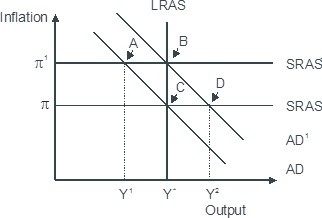Based on the figure below. Starting from long-run equilibrium at point C, a tax cut that increases aggregate demand from AD to AD1 will lead to a short-run equilibrium at point ________ and eventually to a long-run equilibrium at point ________, if left to self-correcting tendencies. 
A. D; C
B. B; C
C. B; A
D. D; B
Answer: D
You might also like to view...
The most common measure of productivity shocks used by real business cycle theorists is
A) the Solow residual. B) average labor productivity. C) the change in the capital stock. D) unit labor costs.
A person who has taken medical leave is
A) in the labor force. B) not in the labor force. C) unemployed. D) a job leaver.
How does the United States compare to other advanced, industrialized economies on the issue of openness?
a. It is completely closed. b. It is one of the less open of them. c. It is about average in openness. d. It is one of the more open of them. e. It is the most open of them.
Governments are also affected by inflation. In which of the following ways is the government affected by inflation?
a. Expected inflation increases the real interest rate paid by the government on its new bond issues (i.e., deficit financing). b. Inflation increases nominal income tax revenues received by the government. c. Inflation automatically decreases government spending. d. All of the above are true. In other words, the government is affected by each one of them.